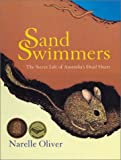This well-researched non-fiction picture book takes readers into the ‘Dead Heart’, a desert wilderness in the centre of Australia.
In a double spread towards the start of the book, author/illustrator Narelle Oliver draws attention to Aboriginal knowledge and understanding of life in the desert. The spread features vignettes of plants and animals with their names in English and three Indigenous languages – Pitjantjatjara, Arrernte and Pintubi. It provides a strong contrast to the pages that follow as Oliver retraces the historical route Charles Sturt, one of the first white explorers, took on an expedition inland into the Dead Heart in 1844.
Sturt’s party experienced an inhospitable environment: salt lakes, mulga scrublands, gibber desert and sand dunes that were seemingly devoid of life. ‘Sand Swimmers’ reveals the myriad creatures hidden from the explorers’ view in each of these terrains. Among the animals featured are salt-lake ground-dragons, pygmy mulga monitors, honey ants, bilbies, gibber-hoppers and marsupial moles. The text explains how some of these creatures have managed to adapt and survive in the harsh desert conditions.
The language is informative and richly descriptive with adjectives, similes and quotes from the early explorers. Each double spread is highly illustrated with most featuring a large linocut print, small, labelled vignettes of desert creatures and, at the bottom of the spread, a coloured pencil drawing of the 1944 expedition and maps of the route taken. The end pages include an index of all the animals, with their names in English and Latin.
‘Sand Swimmers’ was Short-listed in 2000 for the CBCA Eve Pownall Award for Information Books and the Queensland Premier's Award for Children's Literature.
Narelle Oliver (b 1960 – d 2016) was an educator, committed environmentalist and award-winning children's author-illustrator. As an illustrator, Oliver combined linocut, watercolour, pastels, collage and digitally enhanced photographs in her work.

